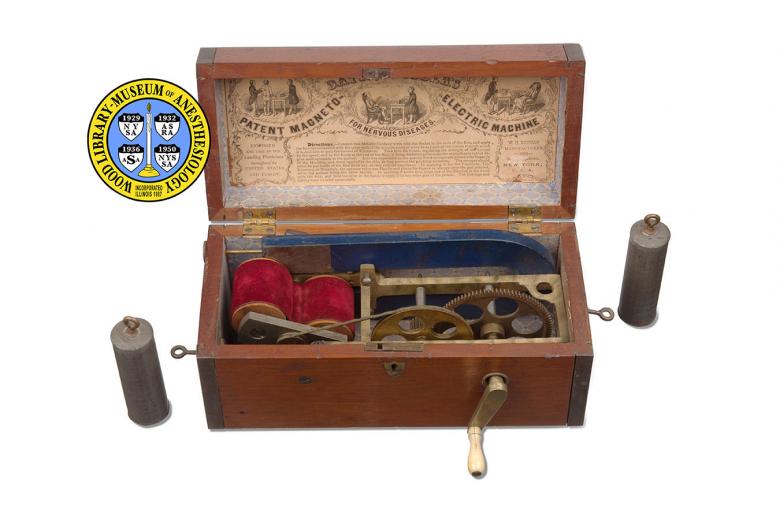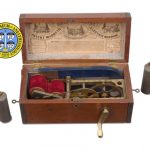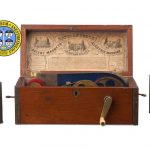Magneto-Electric Machine
Nineteenth-century Americans were fascinated by the promise and mystery of electricity. In 1854, manufacturer W.H. Burnap produced a well-known electrotherapy device that was purchased by the general consumer as well as some physicians and hospitals: The Davis & Kidder Patent Magneto-Electric Machine for Nervous Diseases. The operator of this electromagnetic generator would place handles in the patient’s hands or elsewhere on the patient’s body and then turn a crank to deliver a ‘mild’ alternating current to the patient. The force of the current depended upon the speed with which the crank was turned.
The makers claimed that it could relieve pain, as well as cure numerous diseases, including cancer, consumption (tuberculosis), diabetes, gangrene, heart disease, lockjaw (tetanus), and spinal deformities. Fortunately, serious study of electricity for medicine has also taken place. Scientific investigations into the physiological and possibly therapeutic effects of electricity have led to beneficial uses, including devices used by anesthesiologists to ensure that patients receive proper doses of certain muscle relaxants, to accurately locate nerves for the safe administration of nerve blocks, and to treat chronic pain.
Catalog Record: Magneto-Electric Machine
Access Key: akhq
Accession No.: 2003-11-03-1
Title: Davis & Kidder’s patent magneto-electric machine.
Author: Davis, Ari.
Publisher: New York : W.H. Burnap, 1870-1900.
Physical Descript 1 electric stimulation machine : metals, wood, paper, textile ; 11.5 x 30 x 16.5 cm.
Subject: Electric Stimulation – instrumentation.
Note Type: General
Notes: The early year (1870) of the date range for the possible year of manufacture
is based on the information provided by Dean P. Currier in his text, “Guide
to Electrotherapy Instruments and History of Their American Makers.” On page
187 Currier writes, “The units made in the 1870s and later do not have either
the patent date nor the endorsements on their signature labels.” A generous
end date was provided. The date range could change if documentation indicates
the range should be corrected.
Note Type: Citation
Notes: Currier DP. Guide to Electrotherapy Instruments and History of Their American
Makers. West Conshohocken, Pennsylvania : Infinity Publishing.com; 2005:187.
Note Type: Citation
Notes: Electrical expositions. The Electrical World. May 16, 1896;27(20):551.
Note Type: Citation
Notes: The Improved Magneto-Electric Machine for Nervous Disease. New York: W. H.
Burnap Co.; [1857-1890?]. https://www.electrotherapymuseum.com/2005/DK/.
Accessed July 7, 2013.
Note Type: Citation
Notes: Kneeland TW, Warren CAB. Pushbutton Psychiatry: A History of Electroshock in
America. Westport, Connecticut: Praeger; 2002:1-39.
Note Type: Citation
Notes: Powell GD. The Practice of Medical Electricity. Dublin: Fannin & Co.;
1872:43-47.
Note Type: Citation
Notes: Warner DJ. Everything from watch to locomotive. Rittenhouse. 1989;5:81-93.
Note Type: Physical Description
Notes: A wood box (red stain?) with metal (brass) angled corners, two hinges in back
and a lock in front (key not with device); Protruding from the front of the
box is a brass hand crank with missing handle cover; Within the box are two
rotary wheel gears with pullies that transfer the motion of the hand crank to
the turning of two armatures situated in close proximity to the ends of a
horseshoe magnet; The two armatures are partially covered red velvet; All of
these main parts are connected or held in place by a brass frame; A slotted
flat head machine screw sits flush in the front of the box, to the left of
the lock; Turning this screw adjusts the balance of the rotation of the
armatures (and possibly their distance from the magnet); A round end screw
hook extends from the right and left side of the box; These rounded hooks are
the “sockets” in which the operator would connect the wires that conduct the
electric current to the metal (tin or nickel?) handles; An insulated copper
wire is loosely wound and tucked inside each handle; In the upper corner of
the left side of the box is a flat circular handle that is connected to a
lever; The lever moves a bar of soft lead that is pivoted to the lower leg of
the magnet; The operator could increase the strength of the current by
pulling the handle out (and thus withdrawing the bar of lead from the upper
leg of the magnet; When this handle is pushed into contact with the box the
iron bar has contact with both legs of the magnet and the strength of the
current is diminished; The interior of the box is lined with white and blue
decorative paper; The inside of the upper lid is lined with the
manufacturer’s label; Text on the label in large print includes, “DAVIS &
KIDDER’S [new line] PATENT MAGNETO-ELECTRIC MACHINE [new line] FOR NERVOUS
DISEASES.”; Illustrations of the device being used are interspersed with this
large text; Printed on the lower left side of the label is, “ENDORSED AND
USED BY THE Leading Physicians throughout the UNITED STATES AND EUROPE.”;
Printed on the right lower side of the label is, “W.H. BURNAP, MANUFACTURER
AND [tear with some unreadable text] NEW YORK, U. S. A.”; Directions are
printed in the center of the lower half of the label , they include,
“Directions. ? Connect two Metallic Cords or wires with the Socket in the
ends of the Box, and apply the handles connected with the other ends of the
metallic cords or wires to any part of the person through which it is
desirable to pass the current of Electricity. Then turn the Crank, regulating
the strength of the current by the speed, and by the Knob and the end of the
Box : it being desirable to increase the strength only to that degree most
agreeable to the patient. It is less unpleasant to the patient if wet sponges
are placed over the ends of the Handles, and these applied to the skin, as
they prevent the prickling sensation. The sponges should never be put inside
of the Box while wet, as they rust the machinery. In applying it for the
Toothache, Tic-Doloreux, or Neuralgia, the operator takes one Handle and
places his fingers or sponge over the part affected, while the patient holds
the other handle. In applying it to the foot, place one of the Handles in the
water with the foot, and hold the other in the hand, or apply it to any other
part of the person. The Bearings and Spring must be oiled occasionally.”
Note Type: Reproduction
Notes: Photographed by Mr. Steve Donisch on January 15, 2013.
Note Type: Historical
Notes: Nineteenth-century Americans were fascinated with the promise and mystery of
electricity. They witnessed amazing developments, including the generation of
electricity using magnets and wires, the telegraph, and electric lighting.
Both laymen and physicians saw potential for electricity to help cure disease
Inventors and businessmen saw potential in medical electricity as a market
and, like makers of patent medicines, some manufactures of electrical devices
aggressively marketed their products using exaggerated claims and deceptive
methods.
Note Type: Historical
Notes: During the second half of the 19th century, manufacturer W.H. Burnap produced
a well known electrotherapy device that was purchased by the general consumer
as well as some physicians and hospitals: The Davis & Kidder Patent
Magneto-Electric Machine for Nervous Diseases. The operator of this
electromagnetic generator would place handles, which were connected to the
machine via insulated copper wires, in the patient’s hands or elsewhere on
the patient’s body and then turn a crank to deliver a ‘mild’ electric current
to the patient. Although the name of the device implies that it was intended
for the treatment of “nervous diseases,” a manual published by the
manufacturer in English, German and Spanish provided directions for using the
machine to cure 50 or so diseases, including cancer, diabetes, and gangrene.
Note Type: Historical
Notes: In naming this device W.H. Burnap may have taken advantage of a lucky
coincidence. During the 1800s Daniel Davis of Boston and Dr. Jerome Kidder of
New York were both well-known and respected makers of medical electric
devices. However, there was no direct connection between these two men and
the machine made by W.H. Burnap. Mr. Burnap purchased the patent for his
device from a physician named Walter Kidder. Dr. Walter Kidder purchased the
patent from the inventor as an investment and had no part in the design of
the device. The inventor and original patent holder was Mr. Ari Davis (a
relative of Daniel Davis). Possibly to W.H. Burnap’s benefit, Daniel Davis
and Dr. Jerome Kidder have been erroneously associated with the Davis &
Kidder Magneto for more than a century.
Note Type: Historical
Notes: Fortunately, serious study of electricity and medicine has also taken place.
Scientific investigations into the physiological and possibly therapeutic
effects of electricity have led to beneficial devices including devices used
by anesthesiologists to ensure that patients receive proper doses of certain
muscle relaxers, to accurately locate nerves for the safe administration of
nerve blocks, and to treat chronic pain.
Note Type: Exhibition
Notes: Chosen for the WLM website (noted June 10, 2013).



